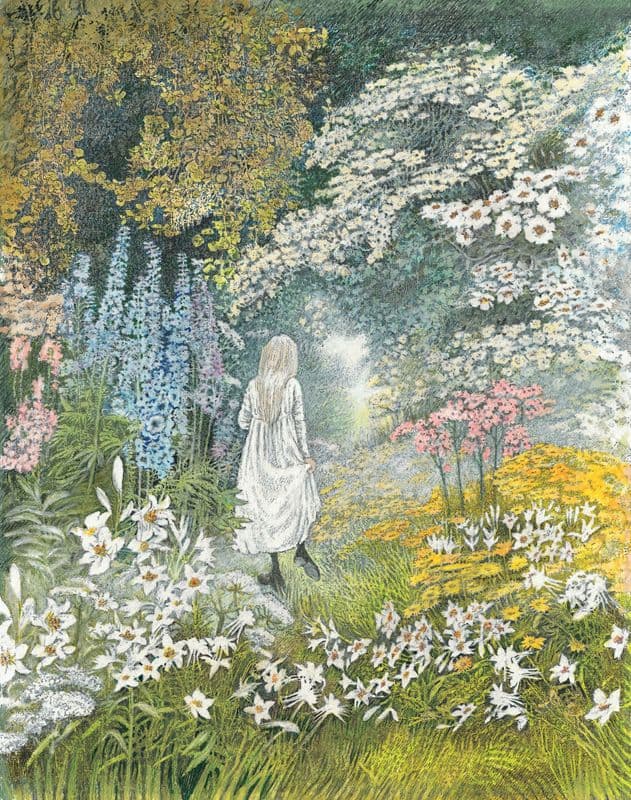Frances Hodgson Burnett’s 1911 novel The Secret Garden is a story of redemption. An unloved and sickly child is left orphaned in British India and is adopted by her uncle in England. Out on the Yorkshire moors, Mary learns to live her own life, and finds her own companionship in the nature of the estate. She makes friends, first in the nature boy, Dickon, and then in her uncle’s discarded and hypochondriacal son Colin. Mary discovers the secret garden, left abandoned at the death of Colin’s mother a decade earlier and in bringing the garden back to life, Mary and Colin are restored to a complete life themselves.

The Secret Garden by Frances Hodgson Burnett, illustrated by Charles Robinson. London: William Heinemann, 1912.
The idea of finding a lost garden and bringing it back to life – or finding a lost anything and bringing it back to the life it might have once had is tempting. We looked at secret garden music (rather than the music for the film The Secret Garden), to see how composers defined their own secret musical gardens.
Fabrice Bollon: The Secret Garden of the Cordania
French conductor and composer Fabrice Bollon, wrote The Secret Garden of the Cordiana for his wife, an electric cellist. Dedicated to his wife, the work, written in 2014, has a title that’s an anagram of her name (which is left unmentioned).
There’s a quiet mystery about the piece – a background pizzicato covered by romantic melodies. Cello figures can be skittish or built in blocks. Because of the minimalist body of an electric cello, extremely high notes are easier to play and Bollon takes advantage of this by writing for the instrument’s highest range, and then countering it with the low-voiced pizzicato.

Electric cello
Fabrice Bollon: The Secret Garden of the Cordania (Johannes Moser, electric cello)
Judith Bingham: The Secret Garden
Judith Bingham’s The Secret Garden from 2004 is about the very first garden – that of Adam and Eve. Bingham wondered how the garden had survived after Adam and Eve were driven out – ‘did God still walk there in the evening, alone and disappointed? Did it become an enclosed world where shame did not exist, a protected and perfect space?’.
Bringham wrote a work she intended to be ‘magical and intriguing’, and she created the text herself, using texts from Linnaeus, on the function of a plant’s leaves; the 17th century writer Joseph Beaumont’s poem The Garden about the Garden of Eden being lost after it was abandoned; quotations from The Bible and then the final section, Vol de Nuit, is about the synergy between plants and insects and is filled with descriptions of exotic moths.

Death’s Head Moth
Judith Bingham: The Secret Garden (BBC Symphony Chorus; Thomas Trotter, organ; Stephen Jackson, cond.)
Uljas Pulkkis: Enchanted Garden
Finnish composer Uljas Pulkkis’s Enchanted Garden from 2000 is a violin concerto that was awarded first prize at the 2001 Unesco International Rostrum of Composers. The work has been described as surreal and as being both concrete and evasive. While playing, the soloist is expected to move around the room, becoming a kind of narrator that the orchestral players comment on and react to in their music. The whole work is set at night, beginning with sunset and it is with the dark that the enchantment (and the secrets) are born. It all ends at sunrise, with the rising light of dawn that the magic comes to an end.

Inga Moore: Mary in the secret garden, 2007
Uljas Pulkkis: Enchanted Garden: A Musical Tale in 8 Chapters – Chapter I: Sunset – Chapter II: Awakening – Chapter III: Enchantment – Chapter IV: Secret – Chapter V: Gathering – Chapter VI: Dance – Chapter VII: Feast – Chapter VIII: Sunrise (Jaakko Kuusisto, violin; Stavanger Symphony Orchestra; Susanna Mälkki, cond.)
Secret gardens can be hidden behind walls or hidden in the dark, hidden in beliefs or hidden in plain sight. They can be the places where we finally discover our true potential or where we discover what was lost so many years ago. Where’s your secret garden and what’s in it?
For more of the best in classical music, sign up for our E-Newsletter


